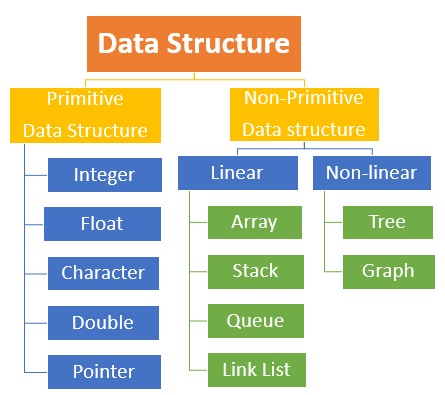Data Structure
What is Data Structure?
Introduction:
“Data Structure” refers to the systematic organization of data to facilitate efficient storage, retrieval, and manipulation. It plays a crucial role in computer science and programming, providing a framework for organizing and managing data elements to optimize algorithm performance. A well-designed data structure enhances the efficiency of operations on the data, leading to improved software performance and overall system reliability.
Analogy:
Imagine a library where books are stored on shelves in a specific order for easy retrieval. Similarly, data structures organize and store information in a systematic manner, making it easier for algorithms to process and manage data.
Definition:
Data structures can be defined as specialized formats for organizing and storing data, designed to facilitate efficient operations such as insertion, deletion, and searching. They can be classified into two main categories:
Primitive Data Structures: Basic data types like integers, floats, and characters that serve as the building blocks for more complex data structures.
Composite Data Structures: Advanced structures like arrays, linked lists, trees, and graphs that are built using primitive data types to solve specific problems efficiently.
Further Description:
Primitive Data Structures:
- Integers, Floats, Characters: Basic data types representing whole numbers, decimal values, and individual characters.
- Boolean: Represents true or false values.
- Pointers: Variables that store memory addresses, allowing efficient data manipulation.
Composite Data Structures:
- Arrays: Ordered collections of elements with a fixed size, accessible using indices.
- Linked Lists: A linear collection of nodes, where each node points to the next one, facilitating dynamic memory allocation.
- Stacks and Queues: Abstract data types with specific rules for adding and removing elements (Last In, First Out for stacks; First In, First Out for queues).
- Trees: Hierarchical structures with a root node and branches, including binary trees, AVL trees, and B-trees.
- Graphs: Non-linear structures composed of nodes and edges, representing relationships between entities.
Why are Data Structures Important?
Efficient Algorithms: Well-chosen data structures contribute to the development of efficient algorithms, optimizing the performance of operations like searching, sorting, and manipulation.
Memory Management: Effective data structures facilitate proper memory allocation and deallocation, reducing memory wastage and enhancing overall system efficiency.
Code Reusability: Standard data structures can be reused across different applications, saving time and effort in software development.
Scalability: Scalable data structures enable applications to handle growing datasets and evolving requirements without sacrificing performance.
Examples and Usage:
Arrays: Used for storing elements of the same data type with constant time access using indices. For instance, an array can store a list of integers representing daily temperatures.
Linked Lists: Ideal for scenarios where dynamic memory allocation is required, such as managing a collection of tasks with varying priorities.
Trees: Employed in hierarchical structures like file systems, where a root directory branches into subdirectories, providing an efficient way to organize and locate files.
Graphs: Applied in social networks to represent relationships between users or in route planning systems to model connections between different locations.
Key Takeaways:
- Data structures organize and store data systematically, optimizing algorithm performance.
- They can be primitive (basic data types) or composite (advanced structures like arrays, linked lists, trees, and graphs).
- Well-designed data structures contribute to efficient algorithms, proper memory management, code reusability, and scalability.
- Examples of data structure usage include arrays for constant time access, linked lists for dynamic memory allocation, trees for hierarchical structures, and graphs for modeling relationships
- In summary, a solid understanding of data structures is fundamental for any programmer or computer scientist, as it lays the groundwork for designing efficient algorithms and building robust software applications.
Table of Contents





